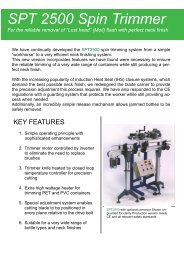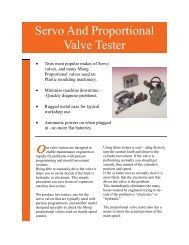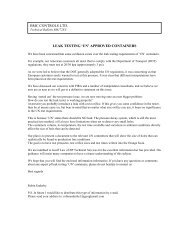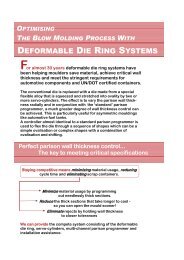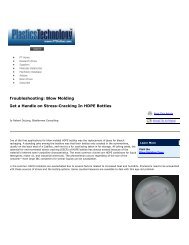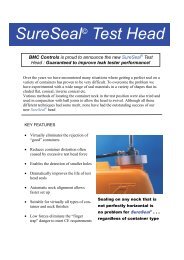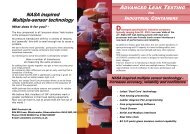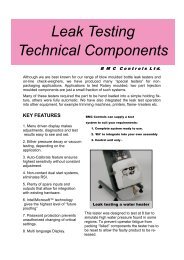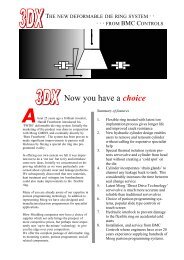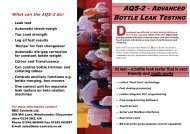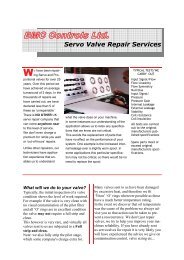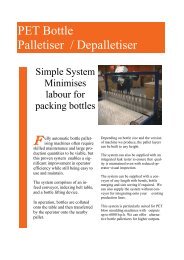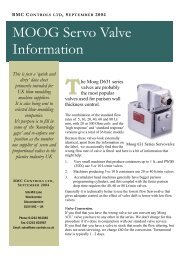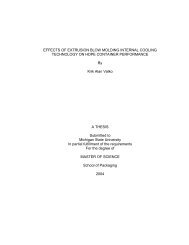internal cooling for the blow molding industry - Blow Moulding Controls
internal cooling for the blow molding industry - Blow Moulding Controls
internal cooling for the blow molding industry - Blow Moulding Controls
Create successful ePaper yourself
Turn your PDF publications into a flip-book with our unique Google optimized e-Paper software.
THE BLOW MOLDING PROCESS<br />
<strong>Blow</strong> <strong>molding</strong> machines melt plastic resins in <strong>the</strong> extruder and push <strong>the</strong> melted plastic through <strong>the</strong> head {1} which <strong>for</strong>ms <strong>the</strong> melt into<br />
pre<strong>for</strong>m {3}. The pre<strong>for</strong>m is <strong>the</strong>n cut in a suitable length and transferred to a cavity {2} inside a mold where compressed air is<br />
introduced inside <strong>the</strong> pre<strong>for</strong>m through a <strong>blow</strong> pin {4} or a <strong>blow</strong> needle. The pressure builds up inside <strong>the</strong> pre<strong>for</strong>m stretching it to <strong>the</strong><br />
shape of <strong>the</strong> cavity. The ambient air between <strong>the</strong> pre<strong>for</strong>m and <strong>the</strong> mold escapes through vents {5} designed in <strong>the</strong> mold. Chilled water<br />
runs continuously through <strong>cooling</strong> channels {6} around <strong>the</strong> cavity in <strong>the</strong> mold {7} <strong>cooling</strong> <strong>the</strong> mold down to a low temperature. The<br />
major difference between <strong>the</strong> temperature of <strong>the</strong> hot pre<strong>for</strong>m and <strong>the</strong> cold surface of <strong>the</strong> cavity allows <strong>for</strong> strong heat withdraw from <strong>the</strong><br />
shaped plastic melt. The shaped product {8} solidifies due to <strong>the</strong> <strong>cooling</strong> and maintains <strong>the</strong> shape of <strong>the</strong> cavity. The mold is <strong>the</strong>n opened<br />
{E} and <strong>the</strong> product is transferred to a trimming station where excessive parts are trimmed off.<br />
The wall thickness distribution is never equal in a <strong>blow</strong> molded part. The mold<br />
<strong>cooling</strong> is not equal on <strong>the</strong> mold surface ei<strong>the</strong>r.<br />
Heat transfer from heavy parts of a <strong>blow</strong> molded product through a limited mold<br />
surface (such as <strong>the</strong> neck and <strong>the</strong> bottom corners of <strong>the</strong> bottle in our example) is<br />
not equal to that of thin walled parts through large surfaces. This in fact causes<br />
more material stress and distortion in <strong>blow</strong> molded products. Material stress leads<br />
to an inferior product quality and <strong>the</strong> product may fail leak, load or drop tests.<br />
<strong>Blow</strong> molders are often <strong>for</strong>ced to increase <strong>the</strong> wall thickness by up to 10% to<br />
produce a good product and pass <strong>the</strong> tests. Increasing <strong>the</strong> weight is combined with<br />
higher material cost and longer cycle time.<br />
The <strong>cooling</strong> time, which is <strong>the</strong> longest part of <strong>the</strong> total cycle time and <strong>the</strong> <strong>blow</strong><br />
<strong>molding</strong> process, is often extended to get <strong>the</strong> heat from <strong>the</strong> part all <strong>the</strong> way through<br />
<strong>the</strong> wall to <strong>the</strong> mold, but a difference in <strong>the</strong> temperature is always expected.<br />
Extending <strong>the</strong> <strong>cooling</strong> time slows <strong>the</strong> production and shrinks <strong>the</strong> profit.<br />
Lowering <strong>the</strong> chilled water temperature in <strong>the</strong> mold leads to a limited improvement. It is suggested to use pure chilled water at a<br />
temperature not lower than 6ºC [43ºF]. The chilled water flow rates are to be at high rates to create turbulent water flow in <strong>the</strong> mold<br />
<strong>cooling</strong> channels.<br />
Adding antifreeze to <strong>the</strong> chilled water to achieve a very low temperature has its disadvantages. Antifreeze agents normally have low<br />
<strong>the</strong>rmal conductivity which lowers <strong>the</strong> heat withdrawal from <strong>the</strong> mold and <strong>the</strong> majority of <strong>the</strong>m have high viscosity which lowers <strong>the</strong><br />
Page 2 of 14<br />
1 (877) 91-FASTI



